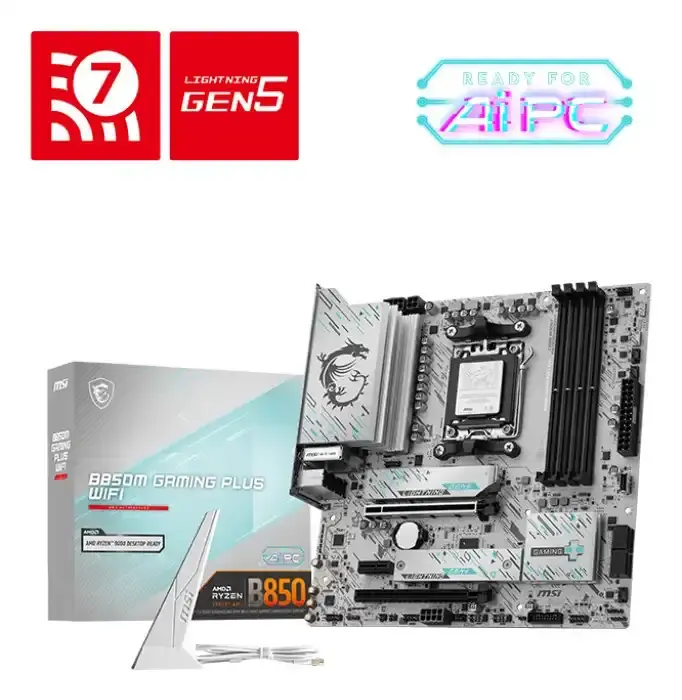Motherboards
Explore our extensive collection of high-performance motherboards designed for gaming, content creation, productivity, and everyday computing. Choose from Intel and AMD motherboard options with support for the latest CPUs and chipsets. Find ATX, microATX, and mini-ITX form factors equipped with cutting-edge features like PCIe 5.0, DDR5 RAM support, Wi-Fi 6E, USB-C, and multiple M.2 slots. Whether you're building a custom gaming rig or upgrading a workstation, we offer top brands like ASUS, MSI, Gigabyte, and ASRock. Compare prices, specs, and reviews to find the best motherboard for your PC build today. Shop smart and power up your performance with the right foundation for your system.
How to Choose the Right Motherboard
Before buying, make sure the motherboard matches your CPU socket, supports the right type of RAM, fits your PC case, and offers enough connectivity and expansion slots for your needs.

1. CPU socket compatibility
The motherboard must match your processor.
Common sockets: Intel LGA1700 / LGA1851, AMD AM4 / AM5.
2. Chipset defines features and performance
Entry to mid-range: Intel B760, AMD B650
High-end & overclocking: Intel Z790/Z890, AMD X670/X870
3. Form factor (board size)
-
ATX – maximum ports and expansion options
-
micro-ATX – balanced choice for most builds
-
Mini-ITX – compact builds with limited expansion
4. RAM support
Check the supported memory type (DDR4 or DDR5), maximum frequency, and number of slots (2 or 4).
5. Storage & expansion options
Look for enough M.2 NVMe slots, PCIe lanes, PCIe 5.0 support (for future GPUs/SSDs), and required SATA ports.
6. Connectivity & I/O ports
Consider the number of USB ports, LAN speed (1G/2.5G/10G), Wi-Fi 6E/7 availability, and integrated HDMI/DP if using an iGPU.
7. VRM quality (power delivery)
A stronger VRM ensures stable performance, especially with high-end processors or heavy workloads.
8. Extra features
Depending on your build:
ARGB headers, reinforced PCIe slots, BIOS Flashback, Thunderbolt/USB4 support, or onboard diagnostics.
Summary
Choosing the right motherboard is essential for system stability, performance, and future upgrade potential.

You might like
FAQ – Motherboards
1. Which motherboard is best for gaming?
For gaming, look for a motherboard with a strong VRM, PCIe 4.0 or 5.0 support, multiple M.2 slots, and a chipset like Intel Z790/Z890 or AMD X670/X870. These offer better stability, more connectivity, and future-proof performance.
2. Do motherboards affect gaming performance?
Direct FPS gains are usually small, but a good motherboard impacts overall system stability, CPU performance, memory speed, and GPU bandwidth. High-end motherboards help unlock the full potential of powerful CPUs and fast RAM.
3. What is the difference between DDR4 and DDR5 motherboards?
DDR5 motherboards support the newer memory standard, offering higher speeds, improved efficiency, and better performance in demanding applications. DDR4 is still cheaper, but DDR5 has become the recommended choice for new builds.
4. How many M.2 slots do I need?
Most modern gaming or productivity builds benefit from at least two M.2 NVMe slots—one for the OS and one for storage or applications. If you use large project files, edit 4K video, or need fast scratch disks, more slots are useful.
5. Can I upgrade my CPU without changing the motherboard?
Only if the new CPU uses the same socket and is supported by the motherboard’s chipset and BIOS version. Intel and AMD change sockets every few generations, so always check compatibility before upgrading.
6. Is a high-end VRM important?
Yes—especially for high-performance CPUs. A strong VRM improves power delivery, cooling, and long-term reliability. This is important for gaming, rendering, and workloads that keep the CPU under heavy load.
7. Do I need built-in Wi-Fi on a motherboard?
It’s optional. If your setup uses Wi-Fi or you want flexibility, choose a board with Wi-Fi 6E or Wi-Fi 7. If you use Ethernet only, a non-Wi-Fi model is usually cheaper.
8. What form factor should I choose?
-
ATX: most expansion, best cooling, ideal for gaming and workstations
-
micro-ATX: good balance of size and features
-
Mini-ITX: very compact builds, fewer slots and ports
Choose based on your PC case size and how many components you plan to install.























































